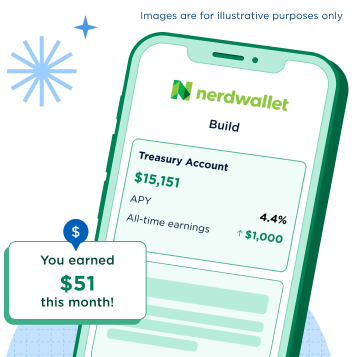Treasury Bills vs. High-Yield Savings Accounts
Both short-term options serve a purpose. Your choice may depend on when you need the cash.

Many, or all, of the products featured on this page are from our advertising partners who compensate us when you take certain actions on our website or click to take an action on their website. However, this does not influence our evaluations. Our opinions are our own. Here is a list of our partners and here's how we make money.
The investing information provided on this page is for educational purposes only. NerdWallet, Inc. does not offer advisory or brokerage services, nor does it recommend or advise investors to buy or sell particular stocks, securities or other investments.
Treasury bills and high-yield savings accounts are both safe places to earn interest on cash that needs to remain accessible in the short-term. Liquidity needs may dictate which one you choose.
Treasury bills
Potential interest rate: 4%+
Treasury bills, or T-bills, are government-backed investments with terms ranging from four weeks to one year. You can buy T-bills from a bank or brokerage, or invest directly through TreasuryDirect.gov.
On TreasuryDirect, you can link your bank account to the site and invest in your T-bill of choice — and have your money automatically reinvested when that T-bill matures, if desired.
Another relatively new option available is a Treasury account, which is offered at some brokerage firms and does the work of buying T-bills for you, holding them to maturity and then reinvesting the profits. (NerdWallet has a partnership with Atomic Treasury to offer a Treasury account. Public, an online broker NerdWallet reviews, also offers a Treasury account.)
AD
Earn 3.93% APY by investing in U.S. Treasury Bills*
Maximize your cash by investing in low-risk, government-backed T-Bills. All the work is done for you — just make the deposit and watch your money grow.
*Rate when held to maturity. Rate shown is subject to price fluctuations.

The advantage of Treasury bills, aside from their low risk and the fact that they’re government-secured, is that the interest you earn is state and local tax-free. You must hold the T-bill to maturity to realize the full gain, so they’re an option for cash you don’t need immediately. You can sell T-bills early, but you might not get full value.
Many brokers also offer a Treasury exchange-traded fund (ETF) or index fund that lets you invest in a basket of different Treasury products.
» Learn more in our full guide on Treasury bills.
High-yield savings accounts
Potential interest rate: 4%+
High-yield savings accounts offer higher interest than savings accounts at traditional banks. Many banks offering these rates are online, and if they’re FDIC-insured, they offer the same protections for your money as brick-and-mortar banks.
If you can get 4% or more (or close to it), you’ll handily beat the national average interest rate for savings accounts, which is 0.42%.
Like most savings accounts, HYSAs typically don’t offer access to funds with check-writing or debit cards, but cash can be transferred out as needed, so these accounts are considered liquid.
» Learn more about high-yield savings accounts.
Article sources
NerdWallet writers are subject matter authorities who use primary,
trustworthy sources to inform their work, including peer-reviewed
studies, government websites, academic research and interviews with
industry experts. All content is fact-checked for accuracy, timeliness
and relevance. You can learn more about NerdWallet's high
standards for journalism by reading our
editorial guidelines.
Related articles







